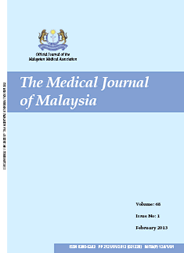MJM, Vol 70 Supplement 1 September 2015
Perception and risk associated to youth alcohol
consumption within different ethnic communities residing in urban and semi
urban areas within Klang Valley, Malaysia
Perdana University-Royal College of Surgeons of Ireland, Selangor
ABSTRACT
Introduction: In May 2013, a study conducted by the Ministry of Health Malaysia reported that approximately 7% Malaysian aged 15-19 were known to consume alcohol within the last 12 months. The objective of the study is to understand communities prospective of the harm associated to youth alcohol drinking within the Malaysian context.
Method: A geo mapping activity in urban and semi-urban areas within Klang Valley was conducted from December 2014 to March 2015, to identify main ethnicity sites such as Setapak (Malay), Cheras (Malay, Chinese), Petaling Jaya (Chinese), Batu (Indian), and Ampang (Indian). The target groups were approached at public places and consent was obtained to explore their perception, knowledge and attitude towards alcohol use within Malaysian youth.
Results: 207 (73 Malays, 79 Chinese, and 55 Indians) youths from a total of 5 sites, completed a self-administered questionnaire. 49% (n=101) participants believed that there are insufficient enforcement on alcohol misuse in Malaysia. 58% participants claimed that Malaysia drinking problem is one of many problems. Whereby 68% (n=140) participants strongly agreed that youth today is consuming alcohol. 72% (n=148) agreed that alcohol consumption leads to risky behaviour (e.g. binge drinking, drink driving, unsafe sex). 21% (n=102) believed that it is acceptable to drink at home. Majority of the respondents (55%, n=113) thinks that safe drinking limit for men is within the range of 1-2 glass of alcohol. 28% (n=57) thinks that 2-4 glass of alcohol a day is safe for men.
Conclusion: The preferred intervention selected by participants is to increase restriction and prohibition. Targeted harm reduction approach (such as stop ignoring the fact that there is an issue of alcohol misuse, go beyond prohibition and promote evidence around the management, prevention and treatment of alcohol misuse) needs to be integrated as public health interventions.
